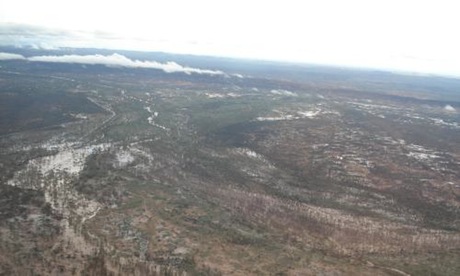
Mosquito populations are exploding across Australia, with warm weather and strong tides bringing hordes of the blood-sucking insects to the east coast while flooding in central Australia has triggered warnings of mosquito-borne viruses.
More than 200mm of rain has hit parts of central Australia since Wednesday, submerging houses in Alice Springs. Standing pools of water are expected to lead to a boom in mosquito numbers, raising fears of disease carried by the insects.
Health authorities are concerned that Murray Valley encephalitis virus, which can lead to coma and brain damage, and the more common Ross River virus, could be spread. Alice Springs residents have been advised to use mosquito repellant liberally and to cover up exposed limbs.
Meanwhile, warm weather followed by rain and king tides have caused mosquito numbers to escalate on the east coast, with Brisbane city council conducting its largest mosquito-reduction effort in 15 years.
In December, the council sprayed 4,400 hectares of public land in order to contain the outbreak of salt marsh mosquitoes, which can carry the Ross River and Barmah Forest viruses.
Increased mosquito activity has also been reported around Sydney and in Gippsland, Victoria.

Dr Cameron Webb, a medical entomologist at the University of Sydney, said his fieldwork suggests the high mosquito numbers are “very unusual” this summer.
“We’ve had the earliest start to a mosquito season I’ve seen in 20 years studying mosquitoes,” he said. “We trap mosquitoes around Sydney and coastal New South Wales and we don’t normally see them until November but we were seeing big populations in October.
“We’d expect to trap 100 to 200 mosquitos in a 12 hour period in November but we were getting 1,000 in October. That’s a four- or five-fold increase, which means we are talking about hundreds of millions of mosquitos on the east coast, if not more.
“People say each year that the mossies are worse than ever, but the difference is this time we have the data to show it.”
Webb said Australia’s warmest spring on record in 2014, for the second year running, has contributed to the mushrooming numbers. This has been aided by rain and tidal activity on the east coast, which has helped the development of mosquitos.
There are around 300 types of mosquito in Australia, and around a dozen of these have the potential to cause public health concerns. A female mosquito can lay up to 200 eggs, meaning a single wetland can produce millions of new mosquitos within a week, if the conditions are right.
“This increase in numbers in in line with expectations of a changing climate,” Webb said. “The risk is less about tropical diseases stretching south into Australia, it’s more about an extended mosquito season, having five months instead of four months.
“The diseases carried by mosquitos in Australia probably won’t kill you but they can be seriously debilitating, causing a fever and rash and leaving you bedridden for many weeks or even months.”
Webb said that there needs to be greater surveillance of mosquito populations so that people are prepared for outbreaks.
“Mosquitos are native animals like frogs and fish, so we have to learn to deal with them, unfortunately,” he said. “We can’t eradicate them completely so we need a strong surveillance program and also to raise community awareness of health risks.
“We have good mosquito repellents but we should all be wearing it like sunscreen, not just a dab here and there.”
